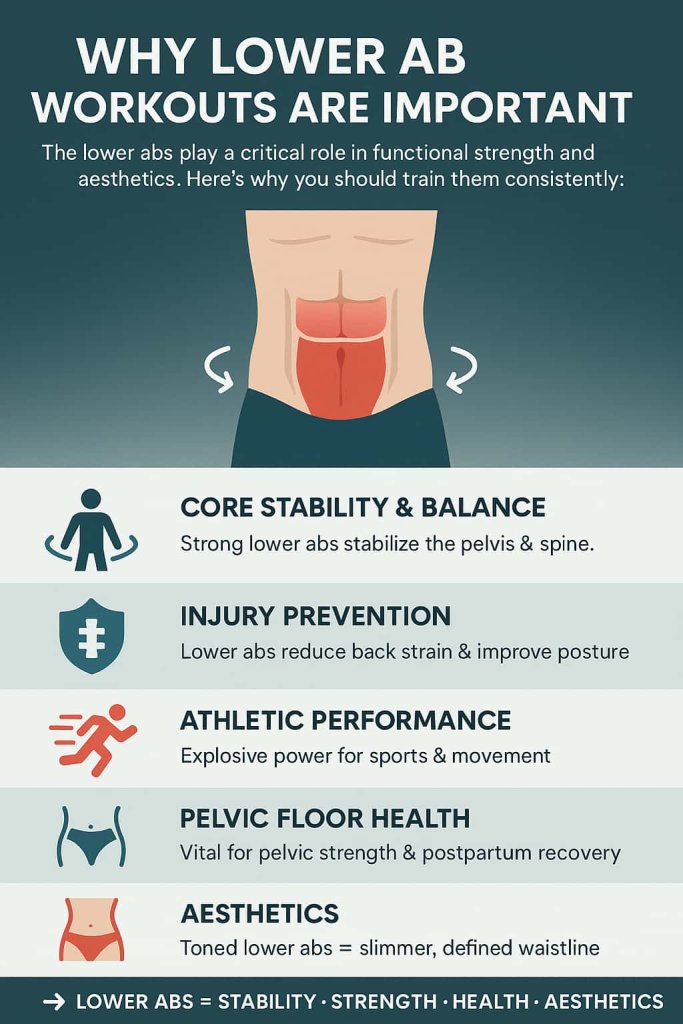Yes, you can flatten your lower abs at home with beginner-friendly moves, but it requires consistency, proper technique, and an overall fitness approach. These exercises strengthen the lower portion of your rectus abdominis and activate deep stabilizers like the transverse abdominis, but remember—spot reduction of belly fat is a myth. To actually see your abs, you’ll also need a balance of cardio, nutrition, and lifestyle changes.

Understanding how to activate your lower abs matters because this region is often the weakest link in core strength. Weak lower abs can contribute to poor posture, back pain, and reduced athletic power. This guide provides 15 beginner-friendly moves you can do at home, supported by expert recommendations, so you can safely tone, tighten, and strengthen your midsection.
Why Lower Ab Workouts Are Important
The lower abs play a critical role in functional strength and aesthetics. Here’s why you should train them consistently:

- Core Stability & Balance → Strong lower abs stabilize the pelvis and spine during daily activities.
- Injury Prevention → Reduces strain on the lower back and improves posture.
- Athletic Performance → Powers explosive movements in sports like tennis, soccer, and golf.
- Pelvic Floor Health → Essential for both men and women, particularly postpartum recovery.
- Aesthetics → Toned lower abs create a slimmer waistline and defined midsection.
15 Best Beginner Lower Ab Workouts at Home
Strengthening the lower abs is key for a toned midsection, better posture, and injury prevention. These 15 beginner exercises require little to no equipment, making them ideal for home workouts. Follow the step-by-step instructions and trainer tips to maximize results safely.
1. Ab Contractions
How to do it:
- Lie on your back with knees bent and feet flat on the floor.
- Place hands on your stomach.
- Exhale and pull your belly button toward the spine while pressing your lower back into the floor.
- Hold for 2–3 seconds, then relax.
Muscles Worked: Transverse abdominis, rectus abdominis.
Trainer Tip: Focus on “drawing in” your abs instead of lifting your shoulders—this ensures deep core activation.
Why It Works: Teaches core engagement and stabilizes your spine before progressing to harder moves.
2. Dead Bug
How to do it:
- Lie flat with arms reaching toward the ceiling.
- Bend knees at 90° above hips.
- Slowly lower your right arm and left leg until just above the floor.
- Return to starting position and switch sides.
Muscles Worked: Rectus abdominis, transverse abdominis, hip stabilizers.
Trainer Tip: Keep your lower back glued to the floor—if it arches, shorten your range.
Why It Works: Builds coordination and core stability, protecting the lower back.
3. Reverse Crunch
How to do it:
- Lie flat with arms at sides.
- Bend knees and lift feet off the ground.
- Curl hips toward your chest while exhaling.
- Lower slowly without dropping your legs.
Muscles Worked: Lower rectus abdominis.
Trainer Tip: Perform slowly—avoid swinging legs for momentum.
Why It Works: One of the best isolation moves for directly targeting lower abs.
4. Leg Drops
How to do it:
- Lie flat, legs extended upward.
- Engage core and lower both legs toward the floor.
- Stop just before touching down, then raise back up.
Muscles Worked: Lower abs, hip flexors.
Trainer Tip: Slightly bend your knees if you feel lower back strain.
Why It Works: Strengthens core while improving control and flexibility.
5. Flutter Kicks
How to do it:
- Lie flat, hands under hips for support.
- Lift legs slightly off the ground.
- Kick them up and down in quick, small motions.
Muscles Worked: Lower abs, hip flexors.
Trainer Tip: Keep core braced—don’t let heels touch the ground.
Why It Works: Builds endurance and burns calories while working deep core muscles.
6. Scissor Kicks
How to do it:
- Same starting position as flutter kicks.
- Cross legs over each other in a scissor-like motion.
- Alternate sides under control.
Muscles Worked: Lower abs, obliques.
Trainer Tip: Move slowly for control and deeper activation.
Why It Works: Adds rotational element to strengthen obliques along with lower abs.
7. Mountain Climbers
How to do it:
- Start in a plank with hands under shoulders.
- Drive one knee toward your chest, then quickly alternate.
- Maintain a steady rhythm.
Muscles Worked: Core, shoulders, hip flexors, quads.
Trainer Tip: Keep hips low and stable—avoid bouncing.
Why It Works: Cardio + core exercise that torches calories and sculpts abs.
8. Boat Pose Hold
How to do it:
- Sit on floor, lean back slightly.
- Lift legs at a 45° angle.
- Balance on sit bones, extend arms forward.
- Hold 20–30 seconds.
Muscles Worked: Lower abs, obliques, hip flexors.
Trainer Tip: Keep spine tall—avoid rounding your back.
Why It Works: Improves core stability and balance while toning abs.
9. Hip Lifts
How to do it:
- Lie flat, legs extended straight upward.
- Use abs to lift hips toward the ceiling.
- Lower slowly under control.
Muscles Worked: Lower rectus abdominis.
Trainer Tip: Imagine lifting with abs, not swinging legs.
Why It Works: Adds vertical resistance, intensifying lower ab engagement.
10. Rocking Plank
How to do it:
- Start in a plank with elbows under shoulders.
- Shift body forward, then backward in a slow, rocking motion.
Muscles Worked: Core, shoulders, glutes.
Trainer Tip: Engage glutes to protect lower back.
Why It Works: Strengthens abs while reinforcing plank stability.
11. The Hundred (Pilates Classic)
How to do it:
- Lie flat, lift legs at 45°.
- Raise head, neck, and shoulders slightly.
- Pump arms up and down while breathing: inhale 5 pumps, exhale 5 pumps.
- Continue until 100 pumps.
Muscles Worked: Core, hip flexors.
Trainer Tip: Keep movement small and controlled—don’t overstrain neck.
Why It Works: Endurance-based ab move that also trains breathing control.
12. Standing Side Crunch
How to do it:
- Stand tall, hands behind head.
- Lift one knee up while lowering elbow toward it.
- Return and alternate sides.
Muscles Worked: Obliques, lower abs.
Trainer Tip: Great option if you dislike floor exercises.
Why It Works: Functional and beginner-friendly, improves mobility and balance.
13. Jackknife Sit-Ups
How to do it:
- Lie flat, arms overhead.
- Simultaneously lift legs and arms to meet in the middle.
- Lower back down slowly.
Muscles Worked: Rectus abdominis, hip flexors.
Trainer Tip: Keep movement slow and avoid jerking forward.
Why It Works: Full-range ab move combining lower and upper abs.
14. Box Plank Up-Downs
How to do it:
- Start in plank on hands.
- Lower onto forearms one arm at a time.
- Push back to hands.
Muscles Worked: Core, shoulders, chest.
Trainer Tip: Keep hips level—avoid twisting side-to-side.
Why It Works: Strengthens abs while adding an upper-body endurance challenge.
15. Standing Wood Chop (Bodyweight or Band)
How to do it:
- Stand with feet shoulder-width apart.
- Interlace fingers (or hold a band).
- Rotate arms diagonally across body in a chopping motion.
- Return and repeat on other side.
Muscles Worked: Obliques, transverse abdominis, shoulders.
Trainer Tip: Focus on torso rotation, not just arms.
Why It Works: Engages abs in a functional twisting motion used in sports and daily life.
How to Structure Your Lower Ab Workout
For beginners:
- Choose 4–5 moves per session
- Perform 2–3 sets each
- Reps: 12–15 reps (or 20–30 seconds for timed holds)
- Rest: 30–60 seconds between sets
- Frequency: 3–4 sessions per week
👉 Certified fitness professionals agree that lower ab exercises should be combined with cardio and full-body resistance training for optimal fat loss and visible core definition—a stance backed by both expert guidance and studies showing superior results from combined training methods.
Nutrition & Lifestyle Tips for Flatter Abs
Training your lower abs without adjusting your lifestyle won’t deliver visible results. Combine workouts with these science-backed strategies:
- Balanced Diet: Include lean protein, whole grains, vegetables, and healthy fats.
- Hydration: Water reduces bloating and aids digestion.
- Sleep: Aim for 7–9 hours; poor sleep raises cortisol, linked to belly fat storage.
- Stress Management: Chronic stress raises abdominal fat through hormonal imbalance.
- Consistency: Visible results typically take 6–12 weeks with regular effort.
👉 Weight loss through diet (or diet plus exercise) leads to significant reductions in both subcutaneous and intra-abdominal fat. A clinical trial found that losing 6–7% of body weight achieved this outcome, highlighting that whole-body fat reduction is key—not just abdominal workouts.
FAQs
1. Can I flatten my lower abs in 2 weeks?
No. Strength gains may be noticeable, but visible results usually take 6–12 weeks.
2. Are these safe for beginners?
Yes. Start with ab contractions, dead bugs, and reverse crunches. Progress gradually.
3. Do I need equipment?
No—all moves can be done at home with just bodyweight. A yoga mat is optional.
4. Do ab exercises burn belly fat directly?
No. Spot reduction is a myth. They strengthen muscle; fat loss requires diet + cardio.
5. How often should I train lower abs?
2–3 times per week is optimal. Light daily activation is fine, but avoid overtraining.
6. What’s the best beginner exercise?
The Dead Bug—it strengthens abs while protecting the lower back.
7. Should I mix ab training with cardio?
Yes. Cardio helps shed fat, while ab training sculpts and strengthens your core.
Conclusion
Flattening your lower abs fast is achievable with the right moves, structured workouts, and a balanced lifestyle. Start with beginner exercises like ab contractions, dead bugs, and reverse crunches, then progress to more dynamic movements like jackknives and wood chops. Pair these with cardio, strength training, and a clean diet to reveal toned abs over time.
👉 Start today with 4–5 of these moves, stay consistent, and you’ll feel stronger in just weeks—and see results in a few months.
